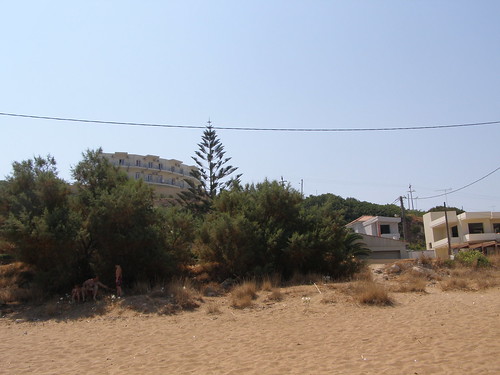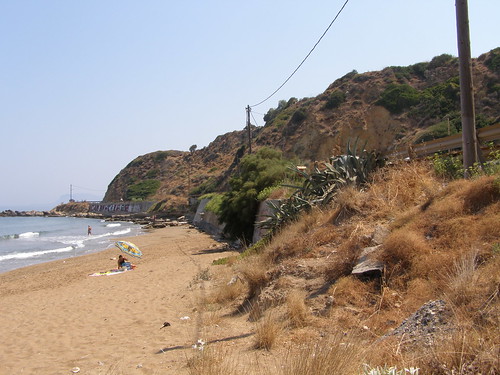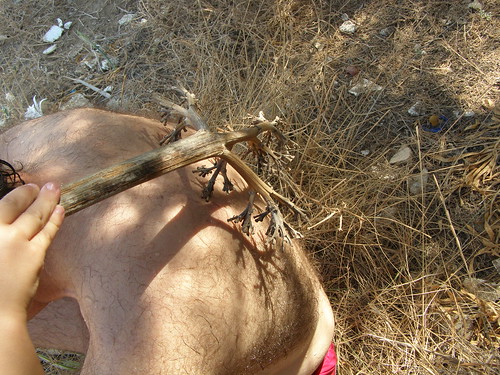When you look at a photo of a beach that looks like this (blue sea below a blue sky, calm crystal waters, sunny skies, warm weather), the first thing you are probably going to think is "I wish I were there."
Yes, why not. Now put yourself in the barefoot camerawoman's feet (and bikini), and turn around to see what's on the other side:
A main road, situated on a dangerous bend (this particular point on the road is also called 'the dangerous Stalos bend' by the locals), with a steady stream of traffic all heading to the same or similar places on the western coastal road out of the main town of Hania. There are also pipes for the water supply trailing down the hillside, and a shop that sells fireplaces and brick barbecues, which is sited in the hollow carved out of the hill to make way for commercial activities.
The scenery gets worse:
... a hilltop hotel with a grotesque unseemly design; nothing in its facade attracts clients, except perhaps the 'magnificent view of the beach' (imagine the climb up to it after your swim). It is exposed to the sun all day, hence the garish A/C boxes above each and every single French window. A few hastily constructed unfinished rooms (with an empty open-air restaurant below one) are strewn haphazardly across the face of the hill, a dirty grey garage shed, and a mound of rubbish under the trees.
The coastal roads did not even have a name for the beaches that were located on them before the advent of tourism. They were simply known as 'yialo', the seashore; the name of the village located above the beach was used to signify the part of the 'yialo' referred to. They were once considered the most desolate places to live, mainly because the land immediately before the beach was thought of as infertile, the salty soil incapable of nurturing anything edible on it. In fact, most of the uninhabited coast was sectioned off in plots and given by the state as a gift to the Asia Minor refugees who came to live in Greece after being expelled from the former Ottoman Empire (now Turkey). When I first came to Crete nearly two decades ago, I clearly remember sheep grazing on some fields in front of the sea, and there were also two brick-making factories located here. The land has now all been turned into hotels, shops, restaurants and other businesses catering to the tourist trade.
You might wonder why we came out here as a family, when we have the choice of so many other places to go for a swim. It's actually quite close to where we live, and the waters are extremely clear. There are no beach umbrellas on this particular site (although there are a little way towards the left), but that should serve as a warning: the area is known for its dangerous riptides, pulling you back into the sea when there is a strong current, rather than pushing you out to the shore. About forty years ago, seven army cadets drowned here, and countless tourists' bodies have been washed ashore over the years. That's not including the road accidents that have caused fatal injuries. You can see a little white rusty iconostasis with a tiny cross between the tamarisk trees and the flax bushes, which is a sure sign that someone has died on this spot; when we left the beach, I noticed that fresh flowers had been laid in it, as well as on other points on the same side of the road, which means that the deceased's families are maintaining the sites where their loved ones left their last breath.
In amongst the horrors of the location, we found that we did enjoy our swim here. The water was cool, fresh and clean. I do recommend you come to Stalos beach too, but just be careful of your steps (and strokes). We also found some dried branches of the flax flower, which make a marvellous back-scratcher...
as well as reindeer horns!






Maria,
ReplyDeletem always envy you have such beautiful beaches in your town.
Im planning a trip to your city hmmm
I just love Crete. Good and bad things. It's my home land of course. I can't be objective.
ReplyDeleteΗ ομορφιά των ελληνικών παραλιών και η εφευρετικότητα των Ελλήνων στο... ξύσιμο είναι μοναδική. Όσο για την τελευταία τι να πεις. Τα πιο χαριτωμένα ελαφάκια που έχω δει
ReplyDeleteI love how you give us insights into all the perspectives of a landscape. This is like my own personal travel journey to a place I can only dream about.
ReplyDeleteWho would have thought that the dry flax flower would make horns or a back scratcher? We use a piece of bent bamboo to scratch our backs. Don't know where it came from but it has been used for years.
ReplyDeleteThese are really nice photographs and the words are nice too as they explain what you see is not always the whole picture.
Nice post.
Another beautiful site of the Greek natural beauty.
ReplyDeleteIf the goverment gives the permition they will build houses on the sand!!!
ReplyDeleteCongratulations!!!You have won an award from me!Look at my blog for more details!
A great 360 degree guided tour.
ReplyDeleteEspecially enjoy the last two pics. You could start exporting those flax branches! (Then I could leave my spaghetti catcher tool in the kitchen drawer.) LOL
It IS a pretty beach, if you keep your eyes toward the water!
ReplyDelete